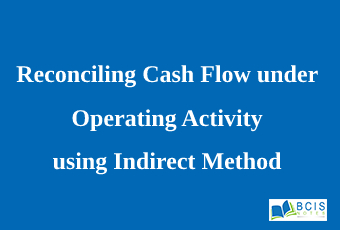
Reconciling Cash Flow under Operating Activity using Indirect Method
Reconciling in Cash flow from operating activities (CFO) indicates the amount of money a company brings in from its ongoing, regular business activities, such as manufacturing and selling goods or providing a service to customers. It is the first section depicted on a company’s cash flow statement.
Reconciling in Cash flow from operating activities does not include long-term capital expenditures or investment revenue and expense. CFO focuses only on the core business and is also known as operating cash flow (OCF) or net cash from operating activities.
The Indirect Method
The less common direct method requires building a cash flow statement from the ground up, using data from potentially thousands of individual transactions, although it’s often difficult to gather data in this manner. Conversely, the indirect method uses information from the company’s income statement and balance sheet, making the cash flow statement preparation a simple exercise.
For the indirect method, start your reconciliation with your company’s net income, or profit, for the desired time period. You’ll find this figure at the bottom of the company’s income statement. Unlike the cumulative nature of the income statement numbers, the balance sheet works like a snapshot, showing data at a certain point in time. For this reason, you’ll need two balance sheets, such as two consecutive monthly versions, because it is the changes in the balance sheet accounts that represent the amounts that have been adjusted.
The Reconciliation
If your company has any gains or losses coming from non-operating activities, you’ll need to also factor these into your reconciliation. Look for gain or loss items on the income statement. Examples include charges related to discontinued operations, and any profit over book value from sales of non-inventory items, such as old equipment or office furniture. Take the appropriate figures from the income statement and add them to your reconciliation.
Start your reconciliation with net income at the top. Add back the total value of non-cash expenses to your operating cash flow. Next, subtract the period change for each category of current assets. Then, add the period change in each category of current liabilities. Some of these period changes might be negative. Finally, add back any expenses related to non-operating activities, and subtract any income from non-operating activities.
Removing a negative charge increases your operating cash flow; adding a negative charge decreases your operating cash flow. Do the math to get to your reconciled cash flow from operations. If you add the two other sections of the cash flow statement, net cash flow from investment activities and net cash flow from financing activities, you’ll have produced a complete cash flow statement.
You may also like Preparation of cash flow statement using direct method

Leave a Reply